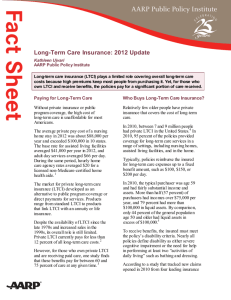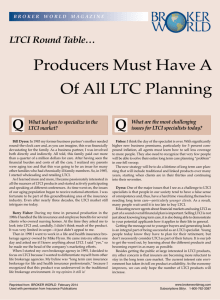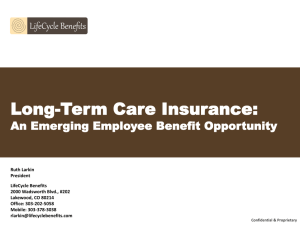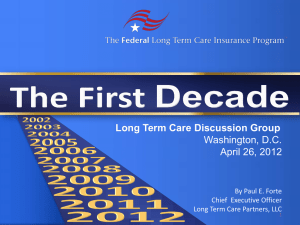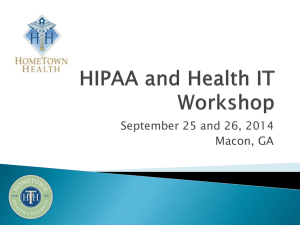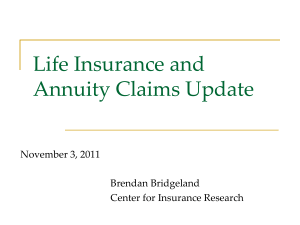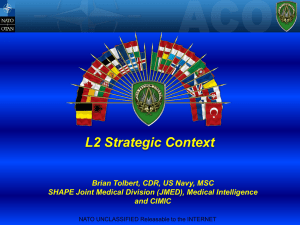LTCI Power Point Presentation – November 2012
advertisement
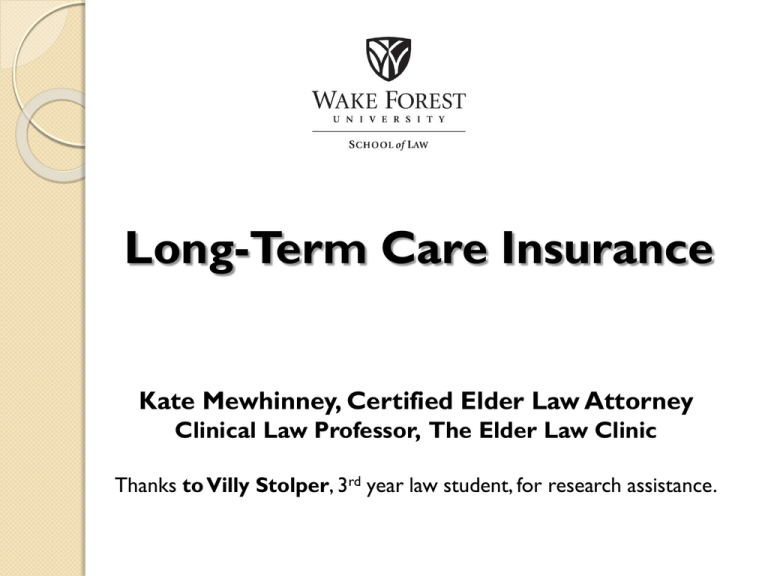
Long-Term Care Insurance Kate Mewhinney, Certified Elder Law Attorney Clinical Law Professor, The Elder Law Clinic Thanks to Villy Stolper, 3rd year law student, for research assistance. Topics 1. How LTC is paid for & who’ll need it. 2. LTC costs in NC. 3. Sources of and paying for LTCI. 4. Tax-qualified LTCI policies. 4. The new Partnership Policies. 5. Cost and affordability of LTCI. 6. What to buy and when. 7. Keeping Medicaid in mind. 8. Assessing the companies. 9. The new hybrids 10. Tax deductibility issues for businesses 11. Public policy issues 1. How LTC is Paid For & Who Needs It In-home services Adult day centers Assisted living (a/k/a domiciliary care, adult care home, rest home) Nursing facility care – SNF and ICF Government Programs Need-based (income/resource rules) ◦ Medicaid (nursing home care) pays for about ½ of all nursing home costs. ◦ Special Assistance (SA) for ALFs or in-home. ◦ CAP/DA Medicare (but only partial coverage in nursing home under some Medicare “Advantage” programs) Veterans Benefits Medicare Covers most older adults. Pays for limited post-hospital home health care. Pays for skilled nursing facility care for up to 20 days in full and 80 days in part, if following a minimum 3 day hospital stay. With Medicare supplement policies, Medicare pays only about 12 % of all LTC costs. Private Sources of Payment Unpaid care from friends and family. Out of pocket (“private pay”). Medicare supplemental insurance (for co-pay during days 20-100 in SNF). Long term care insurance. Who Will Need LTC? 2 of 5 Americans > 65 will enter a NH. 70% of couples, one spouse will need LTC. Half will stay less than 3 months. Other half will stay an av. of 2 ½ years. Less than 2% will stay over 7 years. Odds of Nursing Home Usage Source: Kemper and Murtaugh, New England Journal of Medicine (1991) Odds Increasers Odds Decreasers LTCI history First available in 1987 400,000 83% policies issued in ’07 of buyers purchased before age 65* *American Association for Long Term Care Insurance (AALTI), News Release, 6/17/08 ’07 claims broken down: • 43% for home care; • 33% for assisted living; • 24% for nursing home care.* 8 million have LTCI.* Most are affluent About 10% of those 50+ have LTCI. *AALTI, News Release, 6/17/08 2. LTC Costs in NC. Family care costs jobs/ creates caregiver stress Home Care: $39K - 42K/yr (44 hrs/week) Adult Day Care: $12k/yr Assisted Living: $34K/year Nursing Homes: Semi-Private: $67K/year and Private Room: $73K/year (8 hrs/day, 5 days/wk) 3. LTCI: Sources and Payment Employer (yours or relative’s/partner’s), such as: ◦ Federal LTCI program ◦ State Employees (apply by 6/30/13!) Membership organizations Partnership policies in most states Policies through CCRCs Hybrid life insurance policies Involving the Adult Children Adult children may be financially able to “invest” in a parent’s LTCI policy. Allows the parent to remain at home longer and in more safety and comfort. Also opens the doors to better assisted living options, if necessary. Buying a remainder interest in parents’ home. Other Ways to Finance LTC Reverse mortgages allow the cashpoor and house-rich homeowner to tap the equity in his home. Cashing in a life insurance policy, borrowing against it, accessing a “living need” (if available), and the option of viatical settlements. Advice from? Board certified elder law attorneys Financial advisor (especially CFP) CLTC – Corp. for LTC Certification Use different sources; read fine print. Federal LTCI Program About 20 million people are eligible to apply: employees (most federal/ postal service, active armed services, and D.C. court employees); annuitants (including retired armed services); spouses and adult children of employees and annuitants; and parents, parents-in-law, and stepparents of employees. www.ltcfeds.com Federal LTCI Program John Hancock handles these policies. 268,200 enrollees (as of 6/30/11) Same-sex domestic partners of Federal or U.S. Postal Service employees or annuitants may apply. Offers a facility-only option. Cost of Sample Plan for 55 y o 3 year benefit, 90 day elimination period, and $150 daily benefit (and 5% compound inflation) $159/month ($1,908/yr) for: Home, nursing home, ALF, or hospice (home or not) Bed hold days Home care, adult day care, and respite services Formal and informal caregiver services. Aug. 2012, www.ltcfeds.com 4. Tax-qualified LTCI policies. Most people should only shop for this type. Meets certain requirements of HIPAA (Health Insurance Portability and Accountability Act of 1996). Pre-’97 policies are “grandfathered” in. 90% of policies sold in 2001 were TQ. “Qualified” LTCI premiums are deductible ◦ But limited to excess over 7.5% adjusted gross income (AGI) ◦ Deductibility is unlikely to benefit many “Qualified” plan benefits are not “income.” Unreimbursed (uninsured) LTC costs are deductible. For deductibility issues and small businesses, see last section. 5. The New Partnership Policies They reward people who self-insure by increasing their asset limits under Medicaid. - Ex.: Single person with $100K policy could keep an additional $100K in “countable” assets, and get Medicaid after tapping the full policy. Early ’90’s till 2006: only in 4 states – Robert Wood Johnson Foundation program of “partnership policies” to encourage middle class to buy LTCI. 225,000 policies sold. To save on Medicaid, the federal Deficit Reduction Act (DRA) of 2005 authorizes all states to use partnership policies. Connecticut “Partnership Policies” in ’05: $4,100 premium/year, at age 65 for 3 years, $200 daily benefit, and inflation protection. Majority of purchasers in CA, CT, and IN have assets over $350,000 (excluding home) and half have incomes of $60K or more. Source: Kaiser Commission on Medicaid and the Uninsured. Feb. 2006. www.kff.org/kcmu In 2007, Connecticut estimated that its Partnership program had saved $5.5 million in Medicaid benefits. California estimated over $16 million as of Sept. 30, 2008. NC Partnership Policy Legislation to comport with DRA enacted in ‘10. N.C. Gen. Stat. Chapters 108A and 58-55. Change Notice 02-11 to Medicaid Manual. Inflation protection must be offered for the Partnership Policy to qualify. Compound annual inflation protection must be provided for those under age 61. Purchasers between age 61 and 76, need only be provided some level of inflation protections. NC Partnership Policy Resource disregard at application for LTC Medicaid or CAP and resource protection at estate recovery. (but see the details later…..) Resource disregard and asset protection are equal to benefits paid under the policy P’ship Policy = Harsher Estate Recovery With regards to estate recovery, the definition of estate is much broader for deceased Medicaid recipients who got a resource disregard due to a partnership policy. For p’ship policy holders, “estate” includes: • All real and personal property owned at the time of death. • Those assets conveyed to a survivor, heir or assignee. • Life estates and living trusts. • Ownership interest in joint tenancy with rights of survivorship, tenancy in common and any other arrangement. Drawbacks of Partnership Policies Expanded estate recovery will be a disadvantage for some policyholders’ estates. Many policyholders won’t live long enough or need nursing home care/CAP services long enough to even apply for Medicaid. Asset disregards are more likely to help the insured person’s heirs than the insured person. The heirs won’t be better off, though, if they expect to get: ◦ Remainder interests, ◦ POD interests, ◦ JTWROS interest, or ◦ Inter vivos (living) trust assets. 6. Cost and Affordability of LTCI Median elderly household income: $31K Median income of LTCI buyers: $62,500 - Pension Rights Ctr., “Income of Today’s Older Adults” (‘08 figures) - Am. Health Ins. Plans, “Who Buys Long Term Care Insurance,” 4/07. Annual cost: $1,720*- healthy 55 y o. $2,700 - healthy 55 y o couple _____ $3,335 - healthy 60 y o couple * (Up from $1,480 in 2011, a 16% jump.) Nat’l av. for $150 daily, 3 yrs coverage, 90 day elimination period, 5% inflation protection. AALTI, “2012 LTCI Price Index.” Affordability Standards Some recommend LTCI only if have $75100K aside from home and car. Consumer Reports says not to buy if your net worth is less than $200K (or over $1.5 million). Federally required “suitability test.” Weighing the Costs and Benefits Consider current and future finances ◦ Ability to continue paying the premiums as you age? ◦ What protections does the policy offer if unable to pay the premiums? ◦ Other resources available to help pay for long term care? Tax Credit for LTCI Premiums State law allows a credit of up to $350 for LTCI premium costs. It is restricted however, to the following AGI limits: Married filing jointly…….. .. $ 100,000 Head of Household ……… $80,000 Single …………………..… $60,000 Married filing separately …. $50,000 Those who take deductions on their fed tax return cannot take the NC LTC tax credit. Most people who purchase LTCI do not receive federal tax subsidies. Why? No income tax liability Do not itemize deductions Medical expenses do not exceed 7.5% of AGI Those who do benefit from federal tax subsidies tend to be older and affluent. Federal Tax Credit May Improve A pending bill would improve the tax deductibility of premiums. It would allow individuals a deduction for qualified LTCI premiums, use of such insurance under cafeteria plans and flex spending arrangements, and a credit for individuals with LTC needs. H.R. 6005: Long-Term Care and Retirement Security Act of 2012, 112th Congress, 2011–2012. Out of Reach? Middle class is increasingly being priced out of LTCI market due to premium increases. ◦ New policies prices are up 30-50% compared with 5 years ago, for 55 to 65. ◦ A single 55 y o in standard health pays an average of $2,000/year for middling benefits. ◦ A couple at 65 might pay $5,000. [Source: Jane Bryant Quinn, AARP Bulletin, 6/12] # of new individual buyers dropped by 43 percent from 2004 to 2009. In past five years, at least 14 companies quit selling new individual LTC policies. 7 companies dropped out of the employee-group business. Still service policies but can raise rates. 7. What to Buy and When? What Affects the Policy Cost? Age when policy starts. Length of coverage: 3 yrs, 5 yrs, or lifetime. Elimination period: 30, 90, 180 days Amt of coverage: $100/day or more Other Factors Affecting Cost Inflation protection Home care coverage: none, limited, or including family members Inflation protection Nursing home care costs are increasing at a rate of 5% annually, so today’s daily benefit will not cover future costs Two types of inflation protection Automatic Inflation Protection Special Offer or Non-Automatic Inflation Protection Automatic Inflation Protection An automatic increase in benefits each year Simple vs. Compound Interest Automatic Inflation Protection, cont’d. Compound interest – based on the original principal and any interest earned the previous year (earning interest on interest) ◦ Recommended by most consumer advocates ◦ A $100 daily benefit that increases by a compound 5% annual interest rate will be worth $265 a day in twenty years Automatic Inflation Protection, cont’d. Simple interest – based only on the original principal ◦ A $100 daily benefit that increases by a simple 5% annual interest rate will go up $5 per year and be worth $200 a day in twenty years So, compare protection of $265/day vs. $200/day in 20 years. Special Offer (Non-Automatic) Infl. Protection Allows you to choose to increase your benefits every two or three years If you increase your benefits, your premiums will also increase Two downsides of waiting: ◦ may be more expensive to increase benefits ◦ may have to prove good health in the future “Gatekeeper” provisions Must need substantial assistance with two Activities of Daily Living (ADLs) - eating, toileting, transferring, bathing, dressing, continence, (policy may limit to 5 of those 6) and/or Need for substantial assistance due to “severe cognitive impairment.” Disability Rules for Qualified Policies Must be expected to last > 90 days. Simple “medical necessity” is not enough to constitute disability. For cognitive impairment, a person must require “substantial supervision,” and the impairment must be severe. Desirable Features & Terms, Cont’d. Assisted living & community programs. Respite care and hospice care. Monthly benefit meets person’s needs. Inflation protection: 5% compounded. Benefit period: 5 years would allow asset transfers to get Medicaid eligible. In most states, 1 yr is minimum policy. Desirable Features & Terms, Cont’d. Waiver of premium (to avoid lapse). Waiting period – for as long as client can self-pay. Geriatric care manager services. Adaptation of home for handicap accessibility. Desirable Features & Terms, Cont’d. An ELIMINATION PERIOD is the length of time the individual must pay for services out of pocket before the insurance company will begin to pay. It’s a type of deductible or “waiting period” until the insured begins to collect money from the policy. Compare these options…… 1. Daily - Insured must pay for qualified care from a qualified caregiver for 90 days. Not a good option. May take 6 mos. to satisfy 90-day Elimination Period! 2. Weekly - Must pay for 1 day/wk of qualified care for entire 7 days to count toward 90-day Elimination Period. 3. Calendar Day or Immediately - Policy begins from date the insured assessed as chronically ill by a licensed health care prof’l. This is best option. Some policies have once in a lifetime elimination period - once the elimination period is met, the company begins to pay immediately after a subsequent bout of illness. More Features To Consider Most policies do not pay benefits to family members who give home care. So, some advisors recommend an “indemnity” policy which pays a set amount regardless of who provides care. “Reimbursement” policy is cheaper! LTCI is not available or advisable for: People who have costly illnesses, such as dementia or Parkinson’s. People who cannot afford the premiums due to income and/or age. People with enough income or assets to pay for the costs of long term care. Many issuers are getting picky. A colleague reports that John Hancock Insurance rejects anyone with fibromyalgia (and other chronic illnesses), no matter the individual’s actual health. Mass Mutual rated her as “preferred," despite her fibromyalgia, based on her actual health. Have a particular health problem? Ask the agent to get the underwriting standards for that illness from the companies you are interested in. More Difficult to Be Approved as You Age One out of four 65 year olds is rejected based on physical exams or medical history. One out of three 75 year olds is rejected for these reasons. Who Should Buy LTCI? Age 55; Consumer Reports says 65. 44% of applicants in their 50s qualify for preferred health discounts. 32% of those in 60s do. Concerned about quality of care and/or future of Medicaid; Prefer home care. American Asso. for LTCI, “2009 National Long-Term Care Insurance Price Index.” Who Should Buy LTCI, cont’d. No family caregivers Family history of chronic illness The average age when people begin using the policy is 82, with men beginning to use at an earlier age. What is the financial planning goal for purchasing LTCI? Protect assets, but not monthly income OR Protect assets and monthly income Making this distinction will help to determine how much daily coverage to buy. To protect assets, buy the difference between average daily LTC cost and projected monthly income. To protect income and assets, get a daily benefit to cover full cost of care. Premium Increases Last two years have brought premium increases to policyholders. Insurance prices have increased as a result of the historic low interest rates and yields on fixed income investments. 40 to 60% of the dollars an insurer accumulates to pay future claims comes from investment returns. Benefit Cuts In addition to premium increases, some companies have stopped offering favorable options. Genworth will no longer offer: ◦ Lifetime coverage ◦ 10-pay policies ◦ 40 percent spousal/partner discounts Disqualifying Health Conditions Genworth also announced several health conditions that will automatically disqualify applicants, including certain mental illnesses (such as schizophrenia) and heart issues in combination with tobacco use for 12 months. Considerations for LGBT Couples Discounts for same-sex partners who have lived together in committed relationship for > 3 yrs. Option to share benefit dollars when one partner’s benefit limits have been reached. Options of home and community-based care, and use of company-provided care coordinator. Option of informal caregiver training benefit to train person to provide informal care w/in home. May include spouse or domestic partner. Source: New York Life. 8. Keeping Medicaid in Mind. Income must be lower than the nursing home’s cost, which averages $6,300/mo. in NC. Some assets “countable” and some not. A single person is limited to $2,000 in countable assets. Medicaid Advice from LTCI agents May misstate the rules, esp. for couples. May not understand the transfer rules, especially what transfers are allowed and how long transfers affect eligibility. May not know about non-countable assets that could be purchased. Protections for Married Couples under NC Medicaid Institutionalized spouse limited to $2,000 of countable assets. Community spouse (at home) can keep ½ of countable assets (min. $22,728; max. $113,640. ) 2012 figures in NC: MA-2231.II.B. Non-Countable Assets include: a home of any value a vehicle of any value household goods a prepaid irrevocable burial contract burial plots for applicant/recipient and immediate family. certain types of annuities and trusts. Keep in Mind…. Community Spouse Resource Allowance rules vary considerably state to state. In CA and NY, for example, the community spouse can keep a minimum of $113,640 (and often more, with expert legal assistance). 9. Assessing the Companies Financial stability of insurer ◦ See A.M. Best or Standard and Poor’s ratings. ◦ Look for A+ or A++. Ask about history of rate increases. Cheaper policy isn’t necessarily best! Complaints About Companies A Conseco subsidiary, Bankers Life & Casualty, has more than one complaint regarding long-term care insurance for every 383 such policyholders. Penn Treaty has one for every 1,207. The largest insurer, Genworth Financial, has one for every 12,434 policies. “Aged, Frail and Denied Care by Their Insurers,” by Charles Duhigg, The New York Times, 3/26/07. 10. The New Hybrids (the insurance kind!) Hybrid Life Policies These let a buyer get a cash-value life insurance policy, use part of it for LTC benefits and keep the rest as a death benefit to go to a beneficiary. If LTC benefits are used, the death benefit may be reduced. Hybrid Annuity Policies These let a buyer purchase a fixed deferred annuity with a LTC rider attached. The annuity may pay out for a specific number of years or for life. It functions like a fixed annuity but has a LTC multiplier built into the policy. Example: Purchaser puts $150K into an annuity. It would provide LTC benefits of about $4,700/month for 36 months. There is no return of premium rider attached to this medically underwritten annuity policy. Instead, a portion of the internal return in the contract pays for the LTC benefit. LTC coverage is calculated based on the amount of coverage selected when the policy is purchased. The company offers a payout of 200% or 300% of the aggregate policy value over two or three years after the annuity account value is depleted. If LTC is never needed, the annuity value would then be paid out in a lump sum to any named beneficiary. Tip: A hybrid is typically less expensive than purchasing two separate products, but it is typically more expensive than purchasing a stand-alone LTCI policy. The cash surrender value of the annuity can be used to fund the LTCI portion of the contract without a tax consequence to the contract owner. Charges that normally would be assessed against the annuity’s cash value for such distributions are excluded from gross income. The charges will reduce the basis in the contract and will not be taxdeductible. They may create an incentive for the annuity owner to use those assets when he needs them, rather than spending out of pocket for LTCI coverage he may never use. The contract owner can use the annuity’s cash to fund retirement or long-term care needs, whichever is preferred. ◦ Pension Protection Act (PPA) of 2006, Section 844 Tax-free exchange of certain insurance contracts No gain or loss is recognized on the exchange of a life insurance contract, an endowment contract, an annuity contract for a qualified LTCI contract or the exchange of one qualified LTCI contract for another. PPA Section 1035 11. Tax Deductibility & Businesses A sole practitioner, partner or member of professional LLC can deduct all or part of premiums (for both the practitioner and spouse) from pre-tax dollars, whether or not the practitioner or the business pays premium. C-Corp’s can deduct 100% of premiums. 12. Public Policy Issues Leadership Council of Aging Organizations, made up of 66 national non-profit organizations, encourages broader social coverage of LTC. Members include: American Public Health Association AARP www.lcao.org, accessed July 2012. LCOA members include: Alzheimer’s Association American Association of Homes and Services for the Aging (AAHSA) American Geriatrics Society American Public Health Association American Society on Aging (ASA) Families USA The Gerontological Society of America (GSA) Military Officers Asso. of America (MOAA) National Academy of Elder Law Attorneys (NAELA) Another approach to LTC? Other nations use a social insurance or risk sharing approach ◦ For example, in Germany the risk of LTC costs is spread out by including payments for LTC within its Social Security System Source: James H. Schulz and Robert H. Binstock, Aging Nation: The Economics and Politics of Growing Older in America. Consumer Information Seniors Health Insurance Information Program (SHIIP) www.ncshiip.com/ 800-443-9354 - in NC only National Association of Insurance Commissioners (NAIC) www.naic.org ◦ “Shoppers Guide to LTCI” given out with all policy information. ◦ Free copy from NC Dept. of Insurance 1-800-546-5664 - in North Carolina only Thank you! Kate Mewhinney http://elder-clinic.law.wfu.edu/
